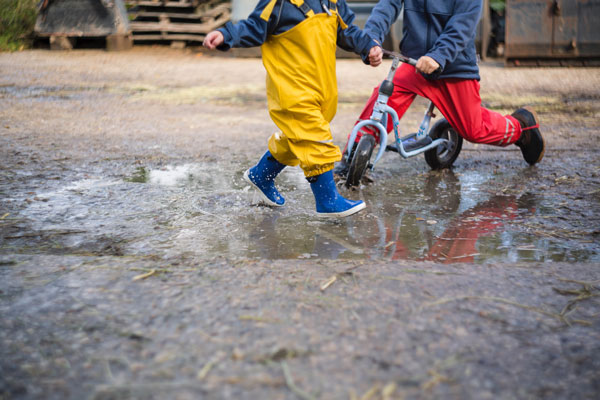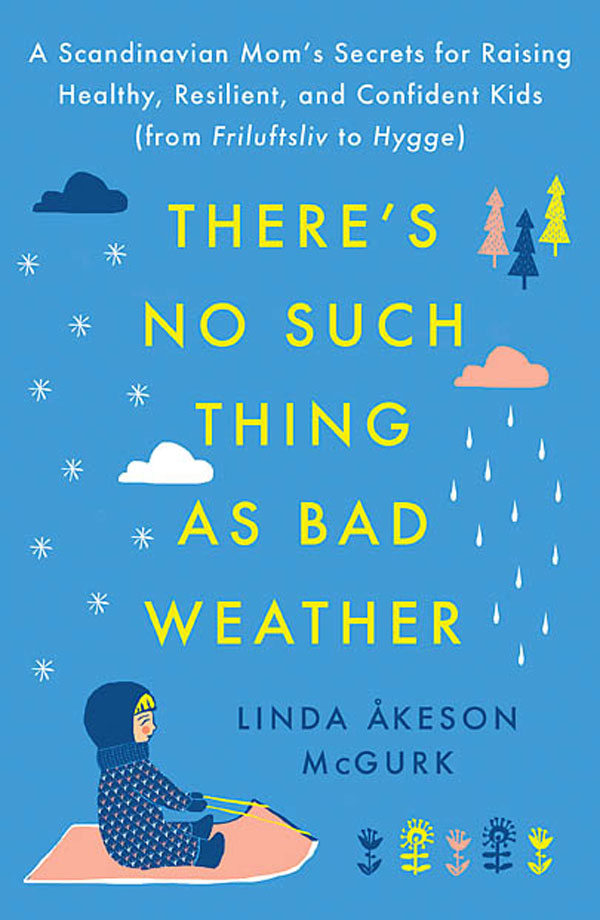
If you’ve ever heard the saying “There’s no such thing as bad weather, only bad clothing” you may also know that it originates in Scandinavia, where dressing for the weather and playing outside all year round are akin to a national sport. Granted that northern Europe is spared from some of the more extreme and potentially dangerous weather conditions that sometimes plague other parts of the world, but the region does get its fair share of rain, snow, sleet and frigid temperatures. That doesn’t stop the Scandinavians from taking their kids outside; in fact, outdoor play in all types of weather is considered key to good health and happiness.
In her book "There’s No Such Thing as Bad Weather: A Scandinavian Mom's Secrets for Raising Healthy, Resilient, and Confident Kids (from Friluftsliv to Hygge)", Swedish-born author Linda Åkeson McGurk describes how babies nap outside, even in the winter, a custom that is encouraged by physicians and practiced both at home and at public preschools and daycares. Children at preschools are even entitled by law to play outside on a regular basis and usually they do for several hours every day. Older kids are also dressed for the weather and sent outside to play rain or shine, and often walk or ride their bikes to get around on their own. At school, students have plenty of recess and unless there’s a thunderstorm brewing, they’re always outside.
There are plenty of reasons for other cultures to borrow a page from the Scandinavian outdoor playbook. Here are four good reasons to encourage children to play outside in less than ideal weather conditions.
1. It keeps them more physically active
Inactivity among American kids is on the rise, creating what some observers call a ticking “health care time bomb,” with obesity, type 2 diabetes and heart disease surely to follow. If couch-surfing your way through childhood is part of the reason behind the recent rise in lifestyle diseases, unstructured outdoor play is the perfect antidote. One study of children who attended Swedish forest schools – essentially all-day preschools where children spend the bulk of their time outside playing in nature – showed that they had lower Body Mass Index, better motor skills and fewer sick days than children who stayed inside more. Staying physically active may also help kids perform better at school. While schools often use indoor recess in classrooms or gyms as an alternative in inclement weather, nothing beats outdoor recess when it comes to keeping kids moving.
2. It fosters resiliency
We often think of our children’s success in terms of their grades at school, but did you know that resilience is a better predictor of future academic success than both IQ and talent? Resilience can be explained as a mix of persistence and passion, or the ability to adapt well in the face of adversity. It is often said to be the one quality all successful people have in common. Nature is the perfect place to develop resilience, because it’s full of challenging elements that kids can test their abilities on. This is especially true when weather conditions aren’t perfect. For a toddler, just the act of putting on winter gear by yourself or plodding around in deep snow can help build resilience.
3. It can help prevent and alleviate sensory issues
There’s something magical about exploring the shifting face of nature as one season turns into the next. Plus, playing outside in various types of weather during different times of the year benefits children’s sensory development. Each season offers different kinds of sensory experiences for a child – catching snowflakes on your tongue in the winter, feeling cold rain drops sprinkle on your face in the spring, running through a sprinkler on a really hot summer day, sinking your hands deep into mud in the fall. Many kids suffer from sensory issues today (also called sensory processing disorder, although this term isn’t yet universally accepted), but letting them play outside in different types of weather and engage with nature hands-on can help prevent that. Some experts even call nature the “ultimate sensory experience.” Conversely, if we keep kids inside during “bad weather,” they’re missing out on many of those experiences.
4. It will help them be prepared
Naturally, we should treat the weather with respect – tornadoes, hurricanes, thunderstorms and other extreme weather events are not a time for outdoor play. But the threshold for what conditions are considered harmful to children seems to have changed, with some schools in the U.S. canceling outdoor recess at 50F and others keeping kids inside at first sight of the slightest sprinkle. In comparison, infants in Finland nap outside in temperatures as low as -16F and children often play outside in the rain. While the dangers of frostbite are real and should be taken seriously, it’s possible to enjoy outdoor play in cold weather with the proper gear and precautions. Learning how to layer clothes and get around in inclement weather can help both children and adults be better prepared in case of a real weather emergency. But it’s a life skill that children will fail to learn if they’re never given the chance to practice it.
Photo credit: Markus Spiske/Unsplash




























